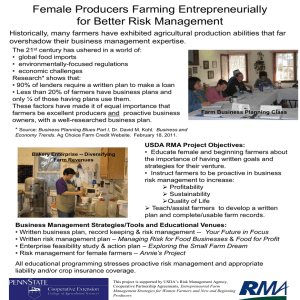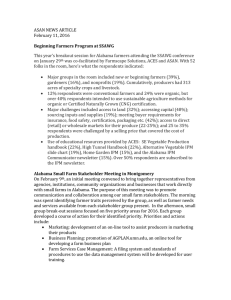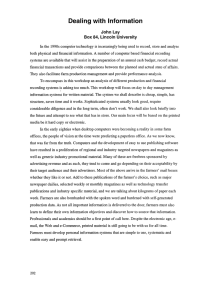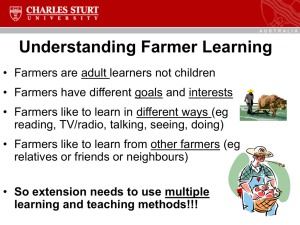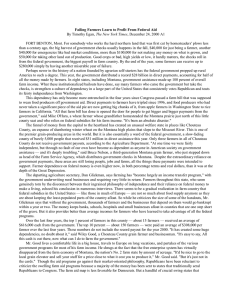December 2009 20 Ways Farmers Can Improve their Marketing Chops
advertisement
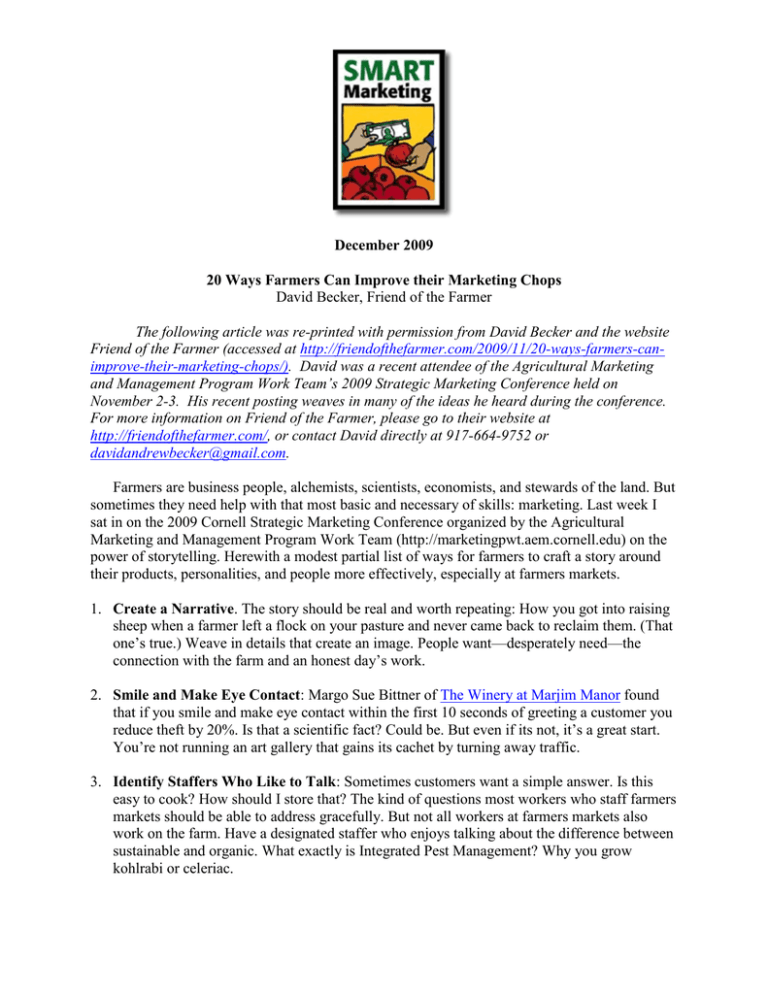
December 2009 20 Ways Farmers Can Improve their Marketing Chops David Becker, Friend of the Farmer The following article was re-printed with permission from David Becker and the website Friend of the Farmer (accessed at http://friendofthefarmer.com/2009/11/20-ways-farmers-canimprove-their-marketing-chops/). David was a recent attendee of the Agricultural Marketing and Management Program Work Team’s 2009 Strategic Marketing Conference held on November 2-3. His recent posting weaves in many of the ideas he heard during the conference. For more information on Friend of the Farmer, please go to their website at http://friendofthefarmer.com/, or contact David directly at 917-664-9752 or davidandrewbecker@gmail.com. Farmers are business people, alchemists, scientists, economists, and stewards of the land. But sometimes they need help with that most basic and necessary of skills: marketing. Last week I sat in on the 2009 Cornell Strategic Marketing Conference organized by the Agricultural Marketing and Management Program Work Team (http://marketingpwt.aem.cornell.edu) on the power of storytelling. Herewith a modest partial list of ways for farmers to craft a story around their products, personalities, and people more effectively, especially at farmers markets. 1. Create a Narrative. The story should be real and worth repeating: How you got into raising sheep when a farmer left a flock on your pasture and never came back to reclaim them. (That one’s true.) Weave in details that create an image. People want—desperately need—the connection with the farm and an honest day’s work. 2. Smile and Make Eye Contact: Margo Sue Bittner of The Winery at Marjim Manor found that if you smile and make eye contact within the first 10 seconds of greeting a customer you reduce theft by 20%. Is that a scientific fact? Could be. But even if its not, it’s a great start. You’re not running an art gallery that gains its cachet by turning away traffic. 3. Identify Staffers Who Like to Talk: Sometimes customers want a simple answer. Is this easy to cook? How should I store that? The kind of questions most workers who staff farmers markets should be able to address gracefully. But not all workers at farmers markets also work on the farm. Have a designated staffer who enjoys talking about the difference between sustainable and organic. What exactly is Integrated Pest Management? Why you grow kohlrabi or celeriac. 4. Be Honest: If someone complains that “these carrots are long and stringy” you can respond “Oh God. Can you imagine what they’re like to wash and harvest? They taste perfectly fine, but next week we have Spanish Blacks that are gorgeous and very rare.” 5. Presentation is Everything: Show abundance when you have it. When you don’t, display products as if they were featured in Martha Stewart’s magazine. Spring for wicker baskets or wooden boxes lined with burlap. You have 10 tomatillos left? Put them in a small basket and highlight them at checkout as an impulse purchase (Make a great salsa verde!). 6. Tell a Story about Your Area: The largest producer of cabbage and sauerkraut in America. Best known for artisanal Munster cheese. Benedict Arnold slept there. Pamela Anderson was born up the street. (Actually Pamela Anderson was born in Ladysmith, British Columbia.) 7. Feature Clear Labels: Easy to read and laminated. Describe the taste and some potential uses. Not all apples make a great pie but every apple has a use. Same is true for potatoes. 8. Provide (Easy) Recipes: There are literally millions of recipes available online. If you don’t cook often pick some and try them. Or have your friends test a recipe. Product trade groups often have a wide range of well-tested recipes. Print them out. Offer to provide a recipe with every purchase. Group together items that go into the recipe into preparation (like a Butternut Souffle that includes squash, onions and thyme). 9. Promote Your Press: If you’ve been featured in any newspaper, blog (even this one), radio or TV report, print it out and laminate it. Make copies for journalists who prowl farmers markets looking for story ideas. 10. Meet Controversy Head On: When there is a food-borne disease story in the news don’t be shy about explaining how your product is different, or how raising your animals is vastly different from a factory operation, and what that means in terms of food safety. 11. Price for Rarity: Describe how the breeds you choose are distinct from what you can buy in the supermarket. More flavor, more vitamins. If something is rare or really hard to grow then narrate your journey of bringing this potato, pig, turkey back from the brink of extinction. Assure the consumer that he or she is now playing a role in preserving this heritage breed. And then price appropriately. 12. Get Good Pictures of Your Farm: There was a time in our history when almost everyone spent some time on the farm. Understanding what goes into raising plants and animals can be translated with a single photo. “There’s our herd of English Black pigs running in a field. There’s a chicken pecking for her favorite meal—grubs.” Show, don’t just tell. 13. Knock Something Off a Big Buy. Amazing how rounding down by 50 cents from $20.50 to $20.00 makes people feel like they’re getting a deal—and you don’t have to spend time making change. 14. Give Free Samples. Get people to try more than one. A winesap vs. a Northern spy. If you make sausages, get out a hot plate and grill up a platter. The aroma will draw fans and sales. 15. Offer Paper Bags and Helping Hands: I sometimes find myself balancing a half dozen butternut squash when a worker comes over and rescues me. Grateful, I turn around and buy something else. 16. Move Quantity: You don’t want to bring your bumper crop home. If it’s getting late, start telling people about making pesto that will keep all year round in ice cube trays. 17. Selling Meat? Then Show It: Don’t just surround yourself with ice chests and a price list. If meat is vacuum bagged and frozen, get trays of ice and put your meat on a tabletop. Start up a small grill and give samples (see #14, above). The smell will pull in buyers—who will be reassured by visual access to the goods. 18. Show Where You Live: If you say your farm is 4-1/2 hours north of Manhattan near Seneca Lake it might as well be the moon for some New Yorkers. Even Albany is a vague location. If you show a map with a pin in it, people begin to get the idea—and how much time it took for you to get to the market to start setting up tables at 6:00 this morning. Customers will leave with a greater appreciation for your hard work. 19. Ask Customers What They Want: No, the customer is not always right but they may inspire you to try something new. If a good customer is asking for a rare potato tell her you’ll try growing it for her next season. You’ve won a customer for life —if you follow through. 20. Maintain a Sense of Humor: That’s not always easy to do if you’ve already been up for 10 hours and a hard rain is starting to fall. But if you can pull it off then your customer will respond with a smile and bigger purchase. And next week they’ll search out your table. “Smart Marketing” is a marketing newsletter for extension publication in local newsletters and for placement in local media. It reviews elements critical to successful marketing in the food and agricultural industry. Please cite or acknowledge when using this material. Past articles are available at http://marketingpwt.aem.cornell.edu/publications.html.



